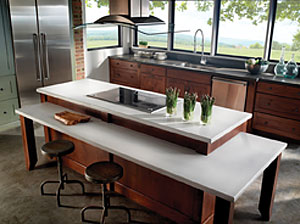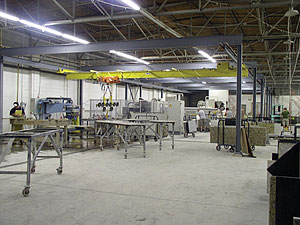
One of the most basic ways a shop can contribute to the environment is to invest in a water recycling system.
photo by Michael Reis
photo by Michael Reis
I was born in 1955 - the same year that Walt Disney opened this place called “Disneyland” in a very far off place that I knew as the state of California. The mood of the country - and for that matter, the world - had nothing to do with any environmental issues. Words like “pollution,” “environment” and “recycling” were not used back then as they are in today’s world. I can remember as a little kid when people would throw trash like beer bottles and beer cans into pristine Wisconsin lakes without having an ounce of guilt about what they had just done. Fortunately, my generation is one that is having to adjust to a new set of public perceptions about the way we treat the environment -especially when it comes to recycling and “going green.”

Recycled countertop products may be finding a stronger market share as part of the green movement. One example of this is ECOTM by Cosentino, a line of countertop and surfacing material composed of 75% recycled material, including mirrors salvaged from houses, buildings and factories; glass from windows and bottles; granulated glass from consumer recycling practices; porcelain from china, tiles, sinks, toilets and decorative elements; and industrial furnace residuals from factories in the form of crystallized ashes.
I have had the good fortune to be able to work with some of the newer “green” countertops that have come out over the last few years, and this exposure helped me to understand, in better detail, the mechanics of the “green” movement and how I can benefit from getting involved. I think that the recycled countertop products are a wave - not THE wave, but a “wave” nonetheless - of the future. It’s only a matter of time until the cement/glass/composite type countertop assembly becomes more refined and cost competitive. I kind of liken the state of the new “green” countertop side of our industry – to that of when I first got into doing fabrication back in 1985.

Another environmental step is to go 100% wet. Many shops are finding that after the initial cost of getting air grinders and the infrastructure to power them (air compressor, dryer, various filters and storage tanks) that they are saving on tool costs and getting a better finished product - with little or no dust generated into the air.
There’s little things that you can do as well, and they will add up over time to show you that you are not only saving money by going green, but in most cases, you’ll also be doing a good thing for the planet too. Here are some of the things (big and little) that shops have found are helpful in greening up and cleaning up at the same time:

Another basic concept is to use your shop floor solely for fabrication - and not for storage of supplies.
• Start recycling the water that you use every day. You’ll be surprised at the amount of water that you’ll be saving - and in many cases, how much less your water bill will be each month.
• Go 100% wet. Many shops are finding that after the initial cost of getting air grinders and the infrastructure to power them (air compressor, dryer, various filters and storage tanks) that they are saving on tool costs and getting a better finished product - with little or no dust generated into the air. OSHA loves this, and it makes for happy employees as well.

• Reuse plastic soft drink bottles by cutting the tops off of them. When they are rinsed out, they can be used as mixing cups for flowing glues. The same can be said for aluminum cans as well, once the tops are removed using a P-38 can opener.
• Use a closed-top shipping container to store tools and other supplies outside - freeing up more floor space in the shop for fabrication instead of storage.
There are many more things that even one person can do over time. I predict that our society will be way more “recycling conscious” than we already are. To some, this is a heavy concept, but as a business, I think that it’s in our best interest to become more active and aware of how we can help recycle more and get more done without affecting the environment.